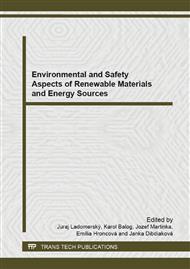[1]
B. Rivela, T. Morreira and G. Feijoo: International Journal of Life Cycle Assessment Vol. 12 (2007), pp.143-150.
Google Scholar
[2]
Agenda 21, on Sustainable Construction, CIB Report Publication 237, Rotterdam, (1999).
Google Scholar
[3]
Regulation No. 305/2011 of the European Parliament and of the European Council, which lays down harmonized conditions for the marketing of construction products.
Google Scholar
[4]
SETAC – Society of Environmental Toxicology and Chemistry. Information on http: /www. setac. org.
Google Scholar
[5]
M. Medineckiene, Z. Turskis and E.K. Zavaskas: Journal of environmental engineering and landscape management Vol. 18(2010), pp.118-127.
Google Scholar
[6]
B. Nebel, B. Zimmer and G. Wegener: International journal of life cycle assessment Vol. 11 (2006), pp.172-182.
Google Scholar
[7]
Z.Y. Hu, P.Q. Tan, X.Y. Yan and D.M. Lou: Energy Vol. 33 (2008), pp.1654-1658.
Google Scholar
[8]
A. Stoppato: Energy Vol. 33 (2008), pp.224-232.
Google Scholar
[9]
S.R. Yu and J. Tao: Energy Vol. 34 (2009), pp.476-484.
Google Scholar
[10]
J.P. Garcia, B. Lippke, J. Comnick and C. Manriquez: Wood and fiber science Vol. 37(2005), pp.140-148.
Google Scholar
[11]
B. Riccardo and C. Annalisa: Energy Vol. 30 (2005), pp.952-967.
Google Scholar
[12]
AK. Petersen and B. Solberg: Forest policy and economics Vol. 7 (2005), pp.249-259.
Google Scholar
[13]
P. Koštial, Z. Jonšta, P. Jonšta, M. Mokryšová, I. Ružiak, L. Olejníčková, J. Šišáková and P. Skalková: Materiálová diagnostika (eng. Material diagnostics) (VŠB Ostrava, Czech republic 2012).
Google Scholar
[14]
A.S. Hanna: Concrete Formwork Systems (University of Wisconsin-Madison, USA 1999).
Google Scholar
[15]
J.B. Peters: Practical timber formwork (Chapman and Hall, London 1991).
Google Scholar
[16]
A. Lyons: Materials for Architects and Builders (Elsevier Ltd, 2007).
Google Scholar
[17]
C. Georgopoulos and A. Minson: Sustainable Concrete Solutions (John Wiley and sons, New York 2014).
Google Scholar
[18]
G.Z. Fu, A.W. Chan and D.E. Minns: International journal of life cycle assessment Vol. 8 (2003), pp.137-141.
Google Scholar
[19]
H.H. Khoo: Waste management Vol. 29(2009), p.1892-(1900).
Google Scholar
[20]
G. Jungmeier, F. Werner, A. Jarnehammar, C. Hohenthal and K. Richter: International Journal of Life Cycle Assessment Vol. 7 (2002), pp.290-294.
DOI: 10.1007/bf02978890
Google Scholar
[21]
B. Rivela, A. Hospido, T. Moreira and G. Feijoo: International Journal of Life Cycle Assessment Vol. 11 (2006), pp.106-113.
DOI: 10.1065/lca2005.05.206
Google Scholar
[22]
P. Koštial, I. Ružiak, Z. Jonšta, I. Kopal, R. Hrehuš and J. Kršková: International Journal of Thermophysics Vol. 31 (2010), pp.630-636.
DOI: 10.1007/s10765-010-0745-5
Google Scholar
[23]
P. Koštial, I. Ružiak, Z. Jonšta and M. Tvrdý: Deffect and Diffusion Forum Vol. 297-301 (2010), pp.30-34.
DOI: 10.4028/www.scientific.net/ddf.297-301.30
Google Scholar


